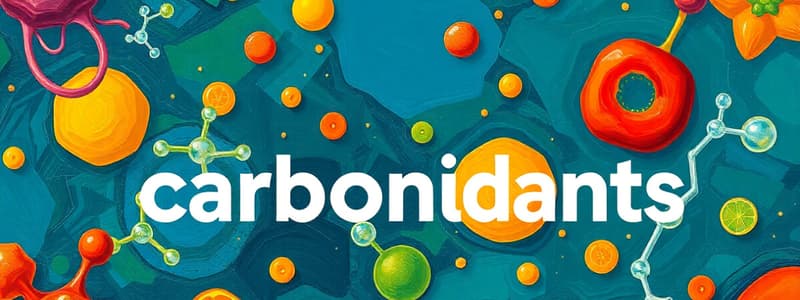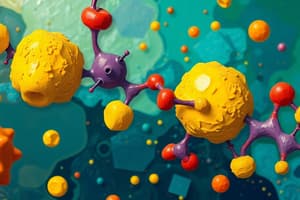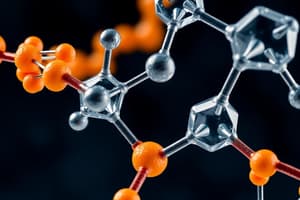Podcast
Questions and Answers
What type of carbohydrates are most abundant in nature?
What type of carbohydrates are most abundant in nature?
- Polysaccharides
- Disaccharides
- Monosaccharides (correct)
- Oligosaccharides
Which statement best describes the formation of disaccharides?
Which statement best describes the formation of disaccharides?
- They are formed through the reaction of a monosaccharide with an acid.
- They comprise two monosaccharides linked by an O-glycosidic bond. (correct)
- They consist of a single mono-olefin unit.
- They contain more than two monosaccharides joined by multiple glycosidic bonds.
Which of the following is NOT a recognized function of carbohydrates?
Which of the following is NOT a recognized function of carbohydrates?
- Providing dietary energy
- Serving as genetic material (correct)
- Facilitating cell recognition
- Acting as structural components
What structural feature do monosaccharides of more than four carbons tend to exhibit?
What structural feature do monosaccharides of more than four carbons tend to exhibit?
In carbohydrate metabolism, what role do complex carbohydrate polymers play?
In carbohydrate metabolism, what role do complex carbohydrate polymers play?
Which carbohydrate is specifically cited as a significant dietary component?
Which carbohydrate is specifically cited as a significant dietary component?
What are the components of carbohydrates classified as polyhydroxy aldehydes or ketones?
What are the components of carbohydrates classified as polyhydroxy aldehydes or ketones?
Which carbohydrates are primarily responsible for lubrication in joints?
Which carbohydrates are primarily responsible for lubrication in joints?
How does photosynthesis relate to carbohydrates?
How does photosynthesis relate to carbohydrates?
What is a common modification found in glucosamine, galactosamine, and mannosamine?
What is a common modification found in glucosamine, galactosamine, and mannosamine?
Which of the following statements about deoxy sugars is correct?
Which of the following statements about deoxy sugars is correct?
What characterizes the acid derivatives referred to as aldonic acids?
What characterizes the acid derivatives referred to as aldonic acids?
N-acetyl-muramic acid contains which structural feature?
N-acetyl-muramic acid contains which structural feature?
Sialic acid is defined as which of the following?
Sialic acid is defined as which of the following?
The term 'lactones' refers to which type of compound formed from sugar acids?
The term 'lactones' refers to which type of compound formed from sugar acids?
How many stereoisomers can a molecule with 4 chiral centers have?
How many stereoisomers can a molecule with 4 chiral centers have?
Which of the following statements about D and L isomers is accurate?
Which of the following statements about D and L isomers is accurate?
Which of the following sugars is an example of a D-aldohexose?
Which of the following sugars is an example of a D-aldohexose?
What defines two sugars as epimers?
What defines two sugars as epimers?
In the context of sugar stereochemistry, what is the reference carbon?
In the context of sugar stereochemistry, what is the reference carbon?
Which of the following statements regarding aldohexoses is true?
Which of the following statements regarding aldohexoses is true?
What occurs predominantly during the formation of hemiacetals and hemiketals?
What occurs predominantly during the formation of hemiacetals and hemiketals?
Which configuration of the hydroxyl group indicates an L isomer?
Which configuration of the hydroxyl group indicates an L isomer?
What is the primary difference between D-glyceraldehyde and L-glyceraldehyde?
What is the primary difference between D-glyceraldehyde and L-glyceraldehyde?
What type of reaction occurs to form hemiketals from ketones?
What type of reaction occurs to form hemiketals from ketones?
The cyclic structures of D-glucose result from the reaction between which two functional groups?
The cyclic structures of D-glucose result from the reaction between which two functional groups?
What percentage of β-D-glucopyranose is present in the equilibrium mixture after mutarotation of D-glucose?
What percentage of β-D-glucopyranose is present in the equilibrium mixture after mutarotation of D-glucose?
Which of the following describes the structure of an intra-molecular hemiacetal?
Which of the following describes the structure of an intra-molecular hemiacetal?
The a-D-glucopyranose form of D-glucose rotates polarized light to what angle in a 10% solution at 20°C?
The a-D-glucopyranose form of D-glucose rotates polarized light to what angle in a 10% solution at 20°C?
What is the systematic name of the b-anomer of D-glucose?
What is the systematic name of the b-anomer of D-glucose?
What is the role of the mutarotase enzyme in carbohydrate chemistry?
What is the role of the mutarotase enzyme in carbohydrate chemistry?
How does mutarotation affect the optical activity of freshly prepared a-D-glucose solution?
How does mutarotation affect the optical activity of freshly prepared a-D-glucose solution?
What distinguishes oligosaccharides from monosaccharides?
What distinguishes oligosaccharides from monosaccharides?
Which of the following statements accurately describes polysaccharides?
Which of the following statements accurately describes polysaccharides?
Which of the following statements about hemiketals is correct?
Which of the following statements about hemiketals is correct?
Which structure is called pyranose in the context of D-glucose?
Which structure is called pyranose in the context of D-glucose?
Which type of monosaccharide contains a carbonyl group at the end of the carbon chain?
Which type of monosaccharide contains a carbonyl group at the end of the carbon chain?
What is the fundamental difference between aldoses and ketoses?
What is the fundamental difference between aldoses and ketoses?
Which of the following descriptions is true regarding monosaccharides?
Which of the following descriptions is true regarding monosaccharides?
Which structural feature provides monosaccharides with optical activity?
Which structural feature provides monosaccharides with optical activity?
In Fischer projection formulas, what does the D designation signify?
In Fischer projection formulas, what does the D designation signify?
Which characteristic distinguishes cellulose from glycogen?
Which characteristic distinguishes cellulose from glycogen?
How many carbon atoms are present in a pentose monosaccharide?
How many carbon atoms are present in a pentose monosaccharide?
Which statement about monosaccharides is incorrect?
Which statement about monosaccharides is incorrect?
Flashcards are hidden until you start studying
Study Notes
Carbohydrates
- Carbohydrates are polyhydroxy aldehydes or ketones, or substances that yield such compounds on hydrolysis.
- Many carbohydrates have the empirical formula (CH2O)n.
- Carbohydrates are the most abundant biomolecules on Earth.
Functions of carbohydrates
- Sugars and starches are important for diet.
- The oxidation of carbohydrates is the central energy-yielding pathway in non-photosynthetic cells.
- Insoluble carbohydrate polymers (glycans) serve as structural and protective elements.
- Some carbohydrate polymers lubricate skeletal joints.
- Complex carbohydrate polymers act as signals that determine intracellular location or metabolic fate of molecules.
Classification of carbohydrates
- Monosaccharides: Single polyhydroxy aldehyde or ketone unit.
- Disaccharides: Two monosaccharides joined by an O-glycosidic bond.
- Oligosaccharides: Short chains of monosaccharide units joined by glycosidic bonds.
- Polysaccharides: Sugar polymers with more than 20 monosaccharide units.
Classification by Functional Group
- Aldoses: Contain aldehyde group.
- Ketoses: Contain keto group.
Classification by Carbon Skeleton
- Trioses: Contain 3 carbon atoms.
- Tetroses: Contain 4 carbon atoms.
- Pentoses: Contain 5 carbon atoms.
- Hexoses: Contain 6 carbon atoms.
- Heptoses: Contain 7 carbon atoms.
Monosaccharides
- Monosaccharides can be either aldoses or ketoses.
- The simplest monosaccharides are glyceraldehyde (an aldotriose) and dihydroxyacetone (a ketotriose).
Monosaccharides are Asymmetric Compounds
- All monosaccharides except dihydroxyacetone contain one or more asymmetric (chiral) carbon atoms.
- Monosaccharides exist as optically active isomers (stereoisomers or enantiomers).
Sugars Have Optical Activity
- Compounds containing chiral centers are optically active.
- They rotate the plane of polarized light.
Stereoisomers
- A molecule with n chiral centers can have 2n stereoisomers.
- Glyceraldehyde has 21 = 2.
- The aldohexoses, with four chiral centers, have 24 = 16 stereoisomers.
- Stereoisomers of monosaccharides are divided into two groups based on the configuration at the chiral center furthest from the carbonyl carbon.
- D isomers have the same configuration as D-glyceraldehyde, and L isomers have the same configuration as L-glyceraldehyde.
- When the hydroxyl group on the reference carbon is on the right in the projection formula, the sugar is the D isomer; when on the left, it is the L isomer.
- Most of the hexoses in living organisms are D isomers.
Epimers
- Two sugars that differ only in the configuration around one carbon atom are called epimers.
- Some sugars occur naturally in their L form, such as L-arabinose.
Formation of hemiacetals and hemiketals
- Aldoses and ketoses are not mainly found in straight-chain forms.
- In aqueous solution, aldotetroses and all monosaccharides with five or more carbon atoms occur predominantly as cyclic structures.
- The carbonyl group forms a covalent bond with the oxygen of a hydroxyl group along the chain, forming hemiacetals or hemiketals.
- This reaction produces an additional asymmetric carbon atom.
Monosaccharides Have Cyclic Structures
- D-glucose exists in solution as an intramolecular hemiacetal.
- This reaction renders the carbon asymmetric and produces two stereoisomers: a and b.
- Six-membered ring compounds are called pyranoses because they resemble pyran.
- Six-membered ring forms of D-glucose are a-D-glucopyranose and b-D-glucopyranose.
Mutarotation
- The optical activity of a freshly prepared solution of a-D-glucose decreases over time and reaches a final value of +52.7°.
- This is due to the conversion of a-D-glucose to b-D-glucose.
- This rotation is called mutarotation.
Mutarotation
- Mutarotation causes the formation of an equilibrium mixture consisting of 63.6% of the β anomer and 36.4% of the a anomer.
- Enzymes use only one of these forms or derivatives.
- Mutarotase enzyme catalyzes the conversion between them.
Pyranoses and furanoses
- Five-membered ring forms of monosaccharides are called furanoses.
Monosaccharide Derivatives
- Many derivatives of monosaccharides exist.
- Modifications include replacing a hydroxyl group with another substituent or oxidizing a carbon atom to a carboxyl group.
Phosphorylated Sugars
- Phosphate esters of sugars are important intermediates in metabolism.
Amino Sugars
- In glucosamine, galactosamine, and mannosamine, the hydroxyl at C-2 is replaced with an amino group.
- The amino group is nearly always condensed with acetic acid, as in N-acetylglucosamine.
Bacterial cell walls
- Bacterial cell walls contain N-acetylmuramic acid, a derivative of glucosamine.
Deoxy Sugars
- Deoxy sugars have a hydrogen substituted for the hydroxyl group at C-6.
- L-fucose and L-rhamnose are deoxy sugars found in plant polysaccharides.
Aldonic Acids and Uronic Acids
- Oxidation of the carbonyl (aldehyde) carbon of glucose to the carboxyl level produces gluconic acid.
- Oxidation of C-6 of glucose, galactose, or mannose forms the corresponding uronic acid: glucuronic, galacturonic, or mannuronic acid.
- Aldonic and uronic acids form lactones.
Sugar Acids
- Glucose forms gluconic, glucuronic, and glucaric acid.
- Galactose forms galactonic, galacturonic, and galactaric acid.
Aldonic Acids and Uronic Acids
- N-acetylneuraminic acid (sialic acid) is a nine-carbon acidic sugar derivative.
Studying That Suits You
Use AI to generate personalized quizzes and flashcards to suit your learning preferences.




